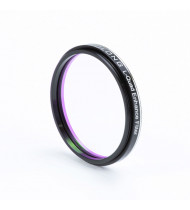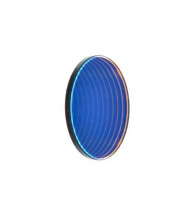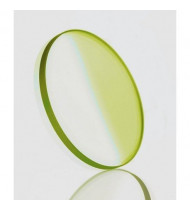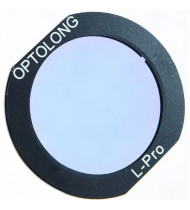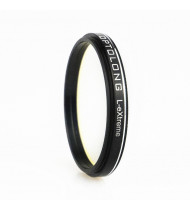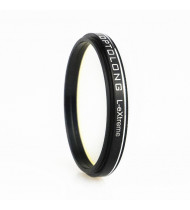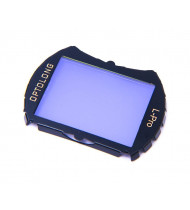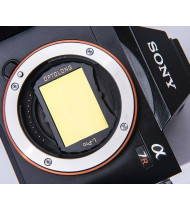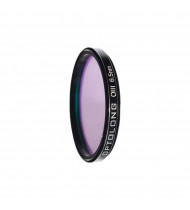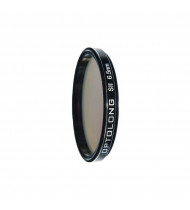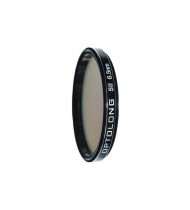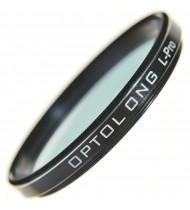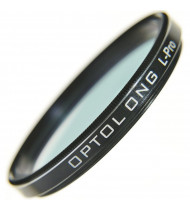Search results for 'steiner navigator pro 7x50 7750007655 4015649000737'
Optolong L-QEF L-Quad Enhance Filter 2"
US$ 208.84L-QEF eliminates light pollution caused by mercury and sodium lamps and produces a broadband image with minimal color cast. This filter is broadband and suppresses wavelengths of light pollution. It is great for star clusters, dark and reflection nebulae, as well as galaxies in skies affected by light pollution.Optolong SII Filter 6.5nm 36mm
US$ 152.92Extra narrowband SII-CCD 6.5nm filter (Sulful II for CCD) is designed for nebula observation allowing 6.5nm bandwidth of light centered on a wavelength of 672nm through, and reducing the transmission of certain wavelengths of light, specifically those produced by artificial light including mercury vapor, and both high and low pressure sodium vapor lights and the unwanted natural light caused by neutral oxygen emission in our atmosphere (i.e. skyglow).
Optolong OIII Filter 6,5nm 36mm
US$ 152.92Extra Narrowband OIII-CCD 6.5nm filter is designed for nebula observation allowing 6.5nm bandwidth of light centered on a wavelength of 500nm through, which corresponds to OIII emission lines, and reducing the transmission of certain wavelengths of light, specifically those produced by artificial light including mercury vapor, and both high and low pressure sodium vapor lights and the unwanted natural light caused by neutral oxygen emission in our atmosphere (i.e. skyglow).
- The L-Pro CCD filter improves the contrast of deep-sky objects and reduces the sky background.
Optolong L-eXtreme Filter 1.25" (31.8mm)
US$ 200.11The advantage of the L-eXtreme filter is that there is no transmission between the H-beta and OIII lines, as there is no nebula emission lines there. In this case, it isn't letting light pollution come through so that maximize nebulas signal and make the sky background darker while imaging. The L-eXtreme filter should better isolate the emission lines only and better protect from light pollution.
Optolong L-eXtreme Filter 2" (50.8mm)
US$ 261.27The advantage of the L-eXtreme filter is that there is no transmission between the H-beta and OIII lines, as there is no nebula emission lines there. In this case, it isn't letting light pollution come through so that maximize nebulas signal and make the sky background darker while imaging. The L-eXtreme filter should better isolate the emission lines only and better protect from light pollution.
- The L-Pro CCD filter improves the contrast of deep-sky objects and reduces the sky background.
Optolong OIII Filter 6,5nm 1.25" (31.8mm)
US$ 130.20Extra Narrowband OIII-CCD 6.5nm filter is designed for nebula observation allowing 6.5nm bandwidth of light centered on a wavelength of 500nm through, which corresponds to OIII emission lines, and reducing the transmission of certain wavelengths of light, specifically those produced by artificial light including mercury vapor, and both high and low pressure sodium vapor lights and the unwanted natural light caused by neutral oxygen emission in our atmosphere (i.e. skyglow).
Optolong SII Filter 6.5nm 1.25" (31.8mm)
US$ 147.67Extra narrowband SII-CCD 6.5nm filter (Sulful II for CCD) is designed for nebula observation allowing 6.5nm bandwidth of light centered on a wavelength of 672nm through, and reducing the transmission of certain wavelengths of light, specifically those produced by artificial light including mercury vapor, and both high and low pressure sodium vapor lights and the unwanted natural light caused by neutral oxygen emission in our atmosphere (i.e. skyglow).
Optolong SII Filter 6.5nm 2" (50.8mm)
US$ 196.61Extra narrowband SII-CCD 6.5nm filter (Sulful II for CCD) is designed for nebula observation allowing 6.5nm bandwidth of light centered on a wavelength of 672nm through, and reducing the transmission of certain wavelengths of light, specifically those produced by artificial light including mercury vapor, and both high and low pressure sodium vapor lights and the unwanted natural light caused by neutral oxygen emission in our atmosphere (i.e. skyglow).
Optolong OIII Filter 6,5nm 2" (50.8mm)
US$ 196.61Extra Narrowband OIII-CCD 6.5nm filter is designed for nebula observation allowing 6.5nm bandwidth of light centered on a wavelength of 500nm through, which corresponds to OIII emission lines, and reducing the transmission of certain wavelengths of light, specifically those produced by artificial light including mercury vapor, and both high and low pressure sodium vapor lights and the unwanted natural light caused by neutral oxygen emission in our atmosphere (i.e. skyglow).
Optolong L-Pro Filter 1.25"
US$ 144.18The L-Pro Astrophotography CCD filter is a filter for improving the contrast of deep-sky objects and dampening the sky background.
- blocks UV and IR (700 - 1100 nm)
- high transmission at passband
- improved color balance for DSLRs and One-Shot Color Astro Cameras, e.g. ASI Color Cameras cooled or uncooled by ZWO.
- high optical quality
- in 1.25" filter cell
- The L-Pro Nebula filter permits roughly 3x longer exposure times than without a filter and therefore improves contrast significantly.
Optolong L-Pro Filter 2"
US$ 166.02The L-Pro CCD filter improves the contrast of deep-sky objects and reduces the sky background.
- blocks UV and IR (700 - 1100 nm)
- high transmission at passband
- improved color balance for DSLRs and One-Shot Color Astro Cameras, e.g. ASI Color Cameras cooled or uncooled by ZWO.
- high optical quality
- in 2" filter cell
- The L-Pro Nebula filter permits roughly 3x longer exposure times than without a filter and therefore improves contrast significantly.


